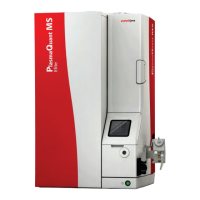PlasmaQuant MS product family Function and setup of the PlasmaQuant MS
29
Fig. 13 Curved pre-filters and mass analyzer
Opposite pairs of rods are connected electrically. Radio frequency and DC potentials
are applied to each pair of rods so that they have equal potential of opposite sign. The
ions to be analyzed enter at one end of the quadrupole and those having the selected
mass-to-charge ratio emerge at the other. Ions with other mass-to-charge ratios have
unstable paths that cause them to be ejected from the quadrupole.
During measurement the absolute magnitude of the potential is increased, so that ions
of increasing m/z will pass through the quadrupole in rapid succession. This is how the
mass spectrum is scanned.
The detector in a quadrupole ICP-MS operates on the same principles as a
photomultiplier tube. An individual ion enters the detector and collides with the first
dynode, knocking out a free electron. This electron is accelerated to the next dynode
where it knocks out several electrons. The amplification process continues until a great
number of electrons are produced at the end of the detector. This large cascade of
electrons is essentially an electrical “pulse” which can be measured by the detector
digital electronics.
Fig. 14 All-digital extended dynamic range detector
The PlasmaQuant MS features a unique all-digital detection system, the AD Detector.
It provides up to eleven orders of linear calibration range without requiring an analog
operating mode. If the option of auto attenuation is selected, the software
automatically chooses a suitable attenuation mode for the detector. When the detector
signal is low, the software automatically turns the attenuation off. This gives the
highest possible sensitivities for the analyte isotopes at a low concentration level, and
therefore achieving the lowest detection limits. The detector has longer life-times
from up to 5 years compared to dual-mode detectors. Furthermore, the detector
doesn´t require frequent cross-calibration as dual-mode detectors do.

